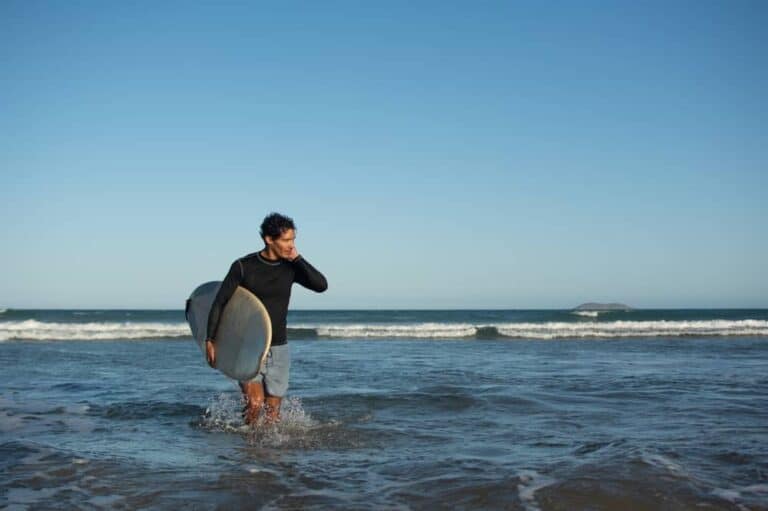How to Treat a Sea Lice Rash (Seabather’s Eruption)

Is there any better way to spend the day than in the ocean? That depends on whether sea lice are present. If you’re unlucky enough to have a run-in with these tiny, transparent creatures during your dip, you may end up wishing you’d done something else. They leave swimmers with a red and bumpy sea lice rash, also known as seabather’s eruption, that can be extremely itchy. In some cases, symptoms such as nausea, vomiting and fever develop as well, especially in children.
A sea lice rash is no one’s idea of summer fun, but since sea lice are nearly impossible to spot, you won’t know they’re there unless a sea lice warning has been posted at the beach. If you see warning signs or flags, spare yourself a rash by staying out of the water. Sea lice season in Florida and elsewhere runs spring through summer, with peak months in May and June, though the critters come and go.
If you do develop seabather’s eruption, there are steps you can take to limit the severity of the rash and ease the itching.
What is sea lice?
Despite their name, sea lice aren’t lice at all. Sea lice in Florida and other southeastern coastal states are the larvae of the thimble jellyfish, or Linuche unguiculata. You’re more likely to come across the other stinging larvae, that of the sea anemone Edwardsiella lineata, farther up the coast, from the mid-Atlantic states to New York.
The larvae feed on the blood of fish and aren’t interested in humans. But if they get trapped under your bathing suit, rash guard, T-shirt or wetsuit, the pressure causes the larvae’s stinging cells, called nematocysts, to sting you and release toxins that result in a rash. It’s similar to being stung by a full-grown jellyfish, though the stings, sometimes mistakenly called sea lice bites, aren’t nearly as painful.
In most cases, symptoms are mild to moderate. The reaction can be more severe in kids, especially those who have allergies or a weakened immune system, and in anyone who’s had seabather’s eruption before.
Sea lice rash symptoms
First you’ll feel a tingling sensation in areas where the larvae got trapped — under your clothing or even in the hair on your head and, for men, the chest hair. The tingling may start while you’re in the water or soon after you’re back on shore. Itching typically develops a few hours later. The rash, made up of small red bumps that may blister, typically appears four to 24 hours after swimming.
About 20% of people with seabather’s eruption develop additional symptoms such as fever, chills, fatigue and nausea.
Is sea lice contagious?
The sea lice rash isn’t contagious. That said, if you loan your bathing suit to someone else without washing or drying it, they could get a rash from the nematocysts that cling to it. You could get stung again yourself if you put the suit back on.
Be sure to wash your bathing suit, and whatever else you swam in, in hot water. If possible, dry it in a dryer. If you develop a severe sea lice rash, consider throwing out the item.
Sea lice treatment
You can’t avoid a rash if you’ve been stung by sea lice, but you can prevent a more severe reaction and treat the rash.
Limit the stings
If you start to feel that tingling sensation in the water or right after swimming, follow these do’s and don’ts to limit further stings for a less severe rash.
Do:
- Remove your bathing suit or other swimming clothing immediately and before taking any other steps.
- If you have it on hand, apply diluted vinegar or rubbing alcohol to the stung areas to neutralize toxins on the skin.
- Rinse your body in fresh water, such as a beach shower.
- Shower and scrub your skin with soap when you get home.
Don’t:
- Rinse yourself, jump in a pool or rub yourself with a towel while still wearing your bathing outfit (all of these can make the trapped sea lice sting you again)
Sea lice bite home remedies
If you develop a mild or moderate sea lice rash, you can treat the symptoms at home. Talk to your child’s doctor before giving the child a pain reliever or antihistamine.
- Wrap ice packs in a towel or cloth and place them on the stung areas.
- Take a non-steroidal anti-inflammatory drug such as ibuprofen to help relieve pain and inflammation.
- Apply calamine lotion or an over-the-counter topical corticosteroid cream (1%) according to the package directions to ease the itching.
- Take an antihistamine to calm the allergic reaction.
When to see a dermatologist
If the rash is severe, see your dermatologist for treatment. He or she may prescribe a topical corticosteroid that’s stronger than over-the-counter versions or an oral corticosteroid. Also contact a doctor if the rash develops signs of infection, such as pus drainage or increased pain, swelling or warmth.
A sea lice rash typically goes away in 10 to 14 days, though in some cases it may last as long as one or two months. The duration depends on the severity of the rash and how sensitive you are to the toxins released by the larvae.
Written by Jessica Brown, a health and science writer/editor based in Nanuet, New York. She has written for Water’s Edge Dermatology, Prevention magazine, jnj.com, BCRF.org, and many other outlets.
Medically reviewed by Ashley E. Falzone, MD


